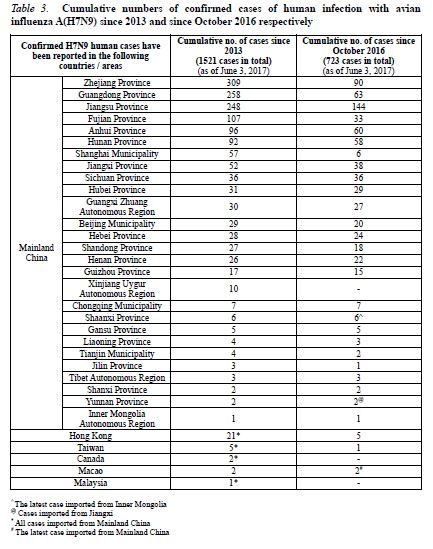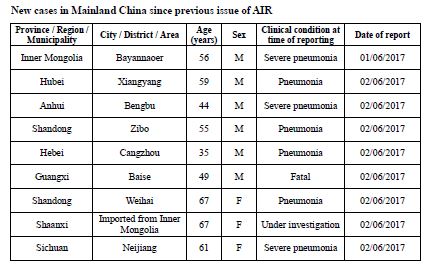 |
| May 31st FAO H7N9 Update |
#12,518
In years past, by early summer, China's H7N9 winter epidemic had pretty much run its course. May always produced fewer than 20 cases, and June, July, and August (combined) rarely produced more than a dozen cases.
While we have seen a dramatic reduction in case reports these past few weeks, the month of May looks as if it will clock in with close to 80 cases, and we appear on track to break all previous summer's records before the month of June is over.Today Hong Kong's CHP has released their week 22 Avian Influenza report which details the 8 cases announced last Friday by China's NHFPC, plus one additional case from Inner Mongolia, reported late last week.
Although we continue to see widely scattered cases from the more southerly provinces (Sichuan, Guangxi), the northern expansion of H7N9 this year - to Shaanxi & Inner Mongolia - may at least partially explain its late season persistence.Additionally, a recent analysis of cases (see Eurosurveillance: Preliminary Epidemiology & Analysis Of Jiangsu's 5th H7N9 Wave) suggested the H7N9 virus might be acquiring more `heat tolerance', something we saw concerns raised over last summer.
While certainly possible, the first real test of that theory should come over the next four months.
Six (of the 9) cases this week were male, the youngest was 35, and thus far - and for the second week in a row - none are reported as fatal. Follow the link below for the full 8-page report.
Avian Influenza Report
Avian Influenza Report is a weekly report produced by the Respiratory Disease Office, Centre for Health Protection of the Department of Health. This report highlights global avian influenza activity in humans and birds.
VOLUME 13, NUMBER 22
Reporting period: May 28, 2017 – June 3, 2017 (Week 22)
(Published on June 6, 2017)
Summary
1. Since the previous issue of Avian Influenza Report (AIR), there were 9 new human cases of avian influenza A(H7N9) reported by health authorities in Mainland China from Shandong (2 cases), Anhui (1 case), Guangxi (1 case), Hebei (1 case), Hubei (1 case), Inner Mongolia (1 case), Shaanxi (1 case) and Sichuan (1 case). Since March 2013 (as of June 3, 2017), there were a total of 1521 human cases of avian influenza A(H7N9) reported globally. Since October 2016 (as of June 3, 2017), 715 cases have been recorded in Mainland China.
2. Since the previous issue of AIR, there were no new human cases of avian influenza A(H5N6). Since 2014 (as of June 3, 2017), 16 human cases of avian influenza A(H5N6) were reported globally and all occurred in Mainland China. The latest case was reported on December 1, 2016.
3. Since the previous issue of AIR, there were no new human cases of avian influenza A(H5N1). From 2011 to 2016, 10 to 145 confirmed human cases of avian influenza A(H5N1) were reported to the World Health Organization (WHO) annually (according to onset date). In 2017, there have been so far three cases in Egypt.*As always, presumably only the `sickest of the sick' seek treatment, and are therefore tested and counted. So the actual burden of the disease - and its mortality rate - remain a matter of continued debate (see Beneath The H7N9 Pyramid).

